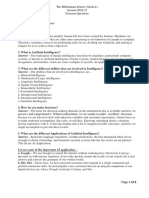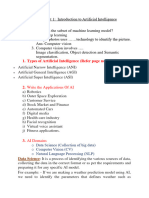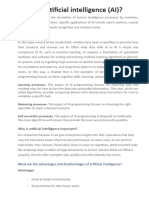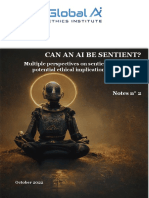0% found this document useful (0 votes)
9 views5 pagesIntro To AI Notes
This document covers the basics of artificial intelligence (AI), including definitions, types of intelligence, applications, and ethical considerations. It explains concepts like machine learning, deep learning, and generative AI, along with the domains of AI such as data science and natural language processing. Additionally, it discusses AI ethics, bias, access, and various ethical issues related to AI deployment and its societal impact.
Uploaded by
devansh700singhCopyright
© © All Rights Reserved
We take content rights seriously. If you suspect this is your content, claim it here.
Available Formats
Download as PDF, TXT or read online on Scribd
0% found this document useful (0 votes)
9 views5 pagesIntro To AI Notes
This document covers the basics of artificial intelligence (AI), including definitions, types of intelligence, applications, and ethical considerations. It explains concepts like machine learning, deep learning, and generative AI, along with the domains of AI such as data science and natural language processing. Additionally, it discusses AI ethics, bias, access, and various ethical issues related to AI deployment and its societal impact.
Uploaded by
devansh700singhCopyright
© © All Rights Reserved
We take content rights seriously. If you suspect this is your content, claim it here.
Available Formats
Download as PDF, TXT or read online on Scribd
/ 5


















































































